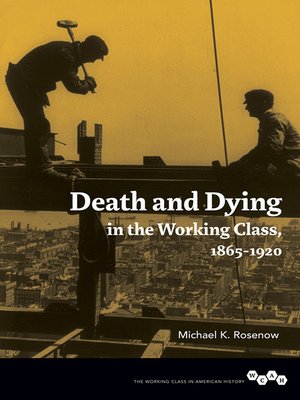Death and Dying in the Working Class, 1865-1920
ebook ∣ Working Class in American History
By Michael K. Rosenow

Sign up to save your library
With an OverDrive account, you can save your favorite libraries for at-a-glance information about availability. Find out more about OverDrive accounts.
Find this title in Libby, the library reading app by OverDrive.



Search for a digital library with this title
Title found at these libraries:
| Library Name | Distance |
|---|---|
| Loading... |
Michael K. Rosenow investigates working people's beliefs, rituals of dying, and the politics of death by honing in on three overarching questions: How did workers, their families, and their communities experience death? Did various identities of class, race, gender, and religion coalesce to form distinct cultures of death for working people? And how did people's attitudes toward death reflect notions of who mattered in U.S. society?
Drawing from an eclectic array of sources ranging from Andrew Carnegie to grave markers in Chicago's potter's field, Rosenow portrays the complex political, social, and cultural relationships that fueled the United States' industrial ascent. The result is an undertaking that adds emotional depth to existing history while challenging our understanding of modes of cultural transmission.
| Title Contents List of Illustrations Acknowledgments Introduction: In Search of John Henry's Body 1. The Marks of Capital: The Accident Crisis and Cultures of Industrialization, 1865–1919 2. The Power of the Dead's Place: Chicago's Cemeteries, Social Conflict, and Cultural Construction 3. Every New Grave Brought a Thousand Members: The Politics of Death in Illinois Coal Communities, 4. As Close to Hell as They Hoped to Get: Steel, Death, and Community in Western Pennsylvania, 1892 Conclusion: (Un)Freedom of the Grave Notes Bibliography Index | Herbert G. Gutman Award, Labor and Working-Class History Association (LAWCHA), 2009. — Labor and Working-Class History Association (LAWCHA)
|Michael K. Rosenow is an assistant professor at the University of Central Arkansas.
Drawing from an eclectic array of sources ranging from Andrew Carnegie to grave markers in Chicago's potter's field, Rosenow portrays the complex political, social, and cultural relationships that fueled the United States' industrial ascent. The result is an undertaking that adds emotional depth to existing history while challenging our understanding of modes of cultural transmission.
| Title Contents List of Illustrations Acknowledgments Introduction: In Search of John Henry's Body 1. The Marks of Capital: The Accident Crisis and Cultures of Industrialization, 1865–1919 2. The Power of the Dead's Place: Chicago's Cemeteries, Social Conflict, and Cultural Construction 3. Every New Grave Brought a Thousand Members: The Politics of Death in Illinois Coal Communities, 4. As Close to Hell as They Hoped to Get: Steel, Death, and Community in Western Pennsylvania, 1892 Conclusion: (Un)Freedom of the Grave Notes Bibliography Index | Herbert G. Gutman Award, Labor and Working-Class History Association (LAWCHA), 2009. — Labor and Working-Class History Association (LAWCHA)
|Michael K. Rosenow is an assistant professor at the University of Central Arkansas.







